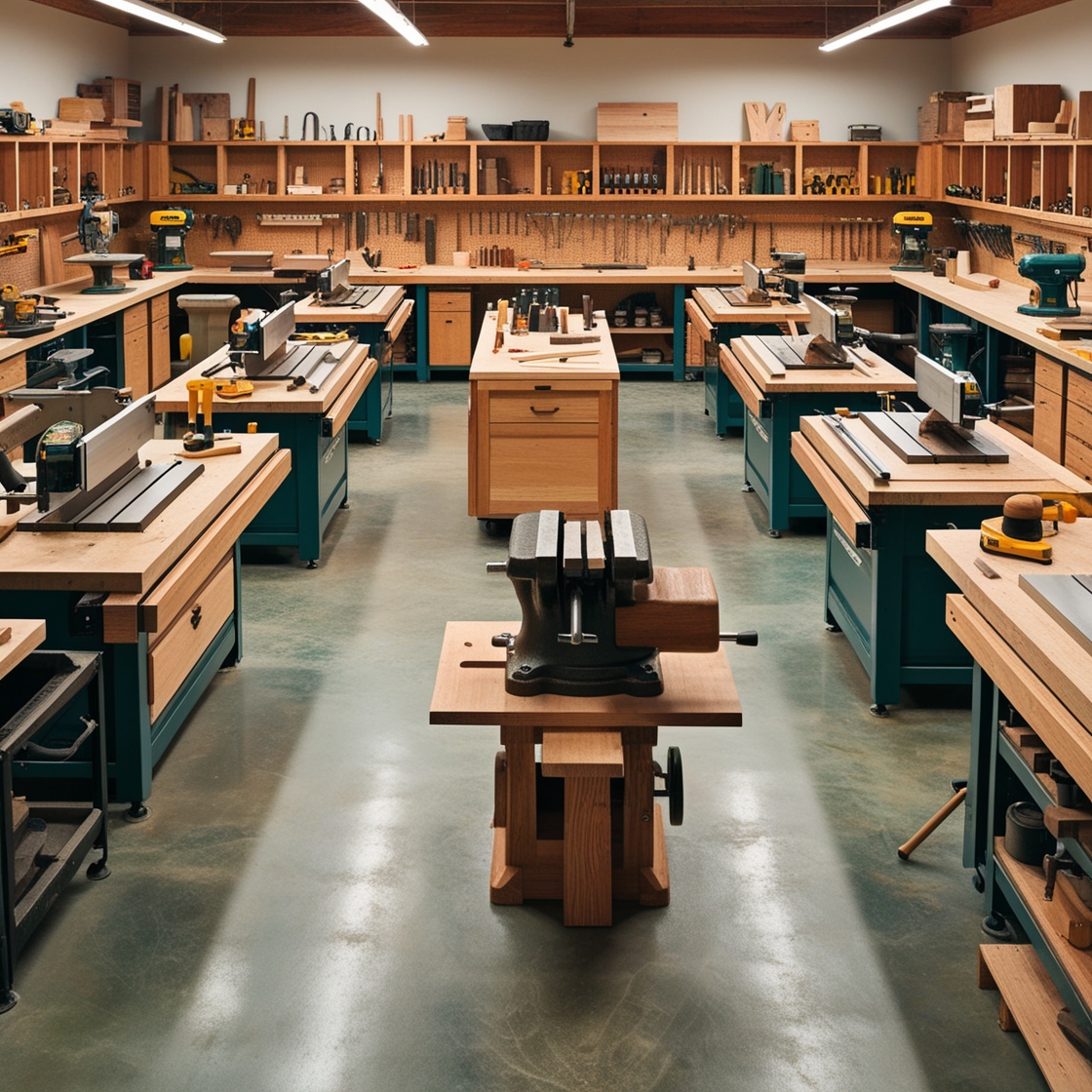Mastering Woodworking: From DIY to Expert Projects
Woodworking is a timeless craft that combines creativity, skill, and patience to transform raw lumber into beautiful and functional objects. Whether you’re a complete novice or an experienced craftsman looking to refine your techniques, this comprehensive guide will take you on a journey through the world of woodworking, from basic DIY projects to expert-level masterpieces.

Getting Started: Essential Tools and Materials
Before diving into your first project, it’s crucial to understand and acquire the basic tools and materials you’ll need. Here’s a list of essentials to get you started:
Hand Tools
- Chisels (various sizes)
- Handsaw
- Claw hammer
- Screwdrivers (flathead and Phillips head)
- Measuring tape
- Carpenter’s square
- Level
- Sandpaper (various grits)
[Image: A layout of essential woodworking hand tools]
Power Tools
- Cordless drill
- Circular saw
- Jigsaw
- Random orbital sander

Materials
- Wood (start with pine or poplar for practice)
- Wood glue
- Screws and nails
- Finishing materials (stains, varnishes, or paints)
Investing in quality tools will make your woodworking experience more enjoyable and yield better results. As you progress, you can expand your toolkit to include more specialized items like a table saw, router, or planer.
Understanding Wood: Types and Characteristics
[Image: Various wood types showcasing different grain patterns and colors]
Choosing the right wood for your project is crucial. Different types of wood have varying characteristics that affect their workability, durability, and appearance. Here’s an overview of some common wood types:
- Softwoods (e.g., pine, cedar, fir): Generally easier to work with and less expensive, ideal for beginners and practice projects.
- Hardwoods (e.g., oak, maple, walnut): More durable and often more visually appealing, but can be more challenging to work with and more expensive.
- Engineered wood (e.g., plywood, MDF): Consistent and stable, good for certain applications but may not have the same aesthetic appeal as solid wood.
When selecting wood, consider factors such as:
- Grain pattern and color
- Hardness and density
- Resistance to moisture and decay
- Cost and availability
Understanding these characteristics will help you choose the right wood for each project and anticipate how it will behave during the woodworking process.
Essential Woodworking Techniques

Mastering fundamental woodworking techniques is crucial for creating successful projects. Here are some key skills to develop:
1. Measuring and Marking
Accurate measurements are the foundation of good woodworking. Learn to use measuring tools like tape measures, squares, and marking gauges effectively. Always remember the old adage: “Measure twice, cut once.”
2. Cutting
Develop proficiency in various cutting techniques:
- Crosscutting (cutting across the grain)
- Ripping (cutting along the grain)
- Mitering (cutting at an angle, typically 45 degrees)
Practice with both hand saws and power saws to understand their strengths and limitations.

3. Joinery
Joinery techniques allow you to connect pieces of wood securely and attractively. Some essential joinery methods include:
- Butt joints
- Lap joints
- Mortise and tenon joints
- Dovetail joints
- Biscuit joints
Start with simpler joints and progress to more complex ones as your skills improve.

4. Sanding and Finishing
Proper sanding and finishing can elevate a good project to a great one. Learn to:
- Sand with progressively finer grits for a smooth surface
- Apply stains evenly to enhance the wood’s natural beauty
- Use different types of finishes (e.g., varnish, lacquer, oil) for protection and aesthetics
[Image: Before and after of a wood surface showing the effects of proper sanding and finishing]
Safety First: Protecting Yourself in the Workshop

Woodworking can be dangerous if proper safety precautions aren’t taken. Always prioritize safety by:
- Wearing appropriate personal protective equipment (PPE):
- Safety glasses or goggles
- Hearing protection when using power tools
- Dust mask or respirator
- Close-fitting clothes and tied-back long hair
- Keeping your workspace clean and organized to prevent tripping hazards and minimize fire risks.
- Using tools properly and maintaining them in good condition.
- Being aware of your surroundings and avoiding distractions while working.
- Having a first aid kit readily available in your workshop.
Progressing from Beginner to Intermediate Projects

As you build confidence and skills, you can tackle more challenging projects. Here’s a suggested progression:
Beginner Projects
- Simple cutting board
- Basic picture frame
- Wall-mounted coat rack
- Small bookshelf
Intermediate Projects
- Coffee table with drawers
- Dining room chair
- Bedside table with curved elements
- Wall-mounted desk with hidden storage
For each project, focus on perfecting specific techniques. For example, when making a coffee table with drawers, you’ll practice precise measuring, creating strong joints, and possibly using a router for decorative edges.
Advanced Techniques for Expert Woodworkers

As you progress to more complex projects, you’ll need to master advanced techniques:
1. Steam Bending
Steam bending allows you to create curved wood pieces without cutting or laminating. This technique is useful for making chairs, boat components, and decorative elements.
2. Inlay Work
Inlaying involves embedding pieces of wood, metal, or other materials into a wood surface to create decorative patterns. This technique can add a touch of elegance to furniture and decorative objects.

3. Veneering
Veneering involves applying thin sheets of high-quality wood over a less expensive substrate. This technique allows you to create beautiful pieces with exotic woods without the high cost of solid lumber.
4. Carving and Sculpting
Wood carving and sculpting open up a world of artistic possibilities. From relief carving to full 3D sculptures, these techniques allow you to create unique, one-of-a-kind pieces.
5. Advanced Joinery
Mastering complex joinery techniques like hand-cut dovetails, intricate mortise and tenon joints, and Japanese joinery methods will elevate your woodworking to new heights.

Tools and Workshop Setup for the Serious Woodworker

As you become more invested in woodworking, consider upgrading your workshop with professional-grade tools and equipment:
- Table saw: The centerpiece of many workshops, a good table saw enables precise cuts and rips.
- Jointer and planer: These machines help you create perfectly flat and square stock, essential for high-quality projects.
- Router table: Allows for precise edge shaping and joinery work.
- Dust collection system: Keeps your workshop clean and protects your lungs from harmful wood dust.
- Workbench: A solid, well-designed workbench is crucial for hand tool work and assembly.
- Clamps: You can never have too many clamps. Invest in a variety of sizes and styles.
Organize your workshop efficiently, with frequently used tools within easy reach and adequate lighting for detailed work.
Designing Your Own Projects

As you gain experience, you may want to design your own unique pieces. Here are some tips for successful project design:
- Sketch your ideas on paper or use computer-aided design (CAD) software for more precise plans.
- Consider the intended use, ergonomics, and aesthetics of the piece.
- Choose appropriate wood species and joinery methods for the project’s requirements.
- Create scale models or prototypes to test your design before committing to full-scale construction.
- Be open to iterating on your design as you encounter challenges or new ideas during the building process.
Sustainable Woodworking Practices

As a responsible woodworker, consider the environmental impact of your craft:
- Use sustainably sourced wood from certified forests.
- Minimize waste by carefully planning cuts and using offcuts for smaller projects.
- Consider using reclaimed or salvaged wood for unique character and reduced environmental impact.
- Choose low-VOC (Volatile Organic Compound) finishes and adhesives when possible.
- Properly dispose of or recycle sawdust and wood scraps.
The Business of Woodworking

For those considering turning their passion into a profession, here are some aspects to consider:
- Develop a unique style or niche to stand out in the market.
- Learn to price your work appropriately, considering materials, time, and skill level.
- Build a portfolio of your best work to showcase to potential clients.
- Understand the legal and financial aspects of running a business, including insurance and taxes.
- Utilize social media and online platforms to market your work and connect with potential customers.
Continuous Learning and Improvement
Woodworking is a lifelong journey of learning and skill development. To continue improving:
- Attend workshops and classes to learn new techniques from experienced craftspeople.
- Join woodworking clubs or online communities to share knowledge and get inspired.
- Read woodworking books and magazines to stay updated on trends and techniques.
- Experiment with different styles and techniques to broaden your skillset.
- Teach others – sharing your knowledge can deepen your own understanding and passion for the craft.
Conclusion
Mastering woodworking is a rewarding journey that combines creativity, technical skill, and patience. From your first simple DIY project to complex, expert-level creations, each piece you make will teach you something new and help you grow as a craftsperson.
Remember that woodworking is as much about the process as it is about the final product. Embrace the challenges, learn from your mistakes, and take pride in the unique pieces you create with your own hands. Whether you’re building functional furniture for your home, crafting artisanal objects for sale, or simply enjoying woodworking as a fulfilling hobby, the skills and knowledge you gain will last a lifetime.
As you progress on your woodworking journey, always prioritize safety, respect the materials you work with, and never stop learning. With dedication and practice, you’ll find that the possibilities in woodworking are as endless as your imagination. So pick up those tools, smell the freshly cut wood, and start creating – your next masterpiece awaits!

